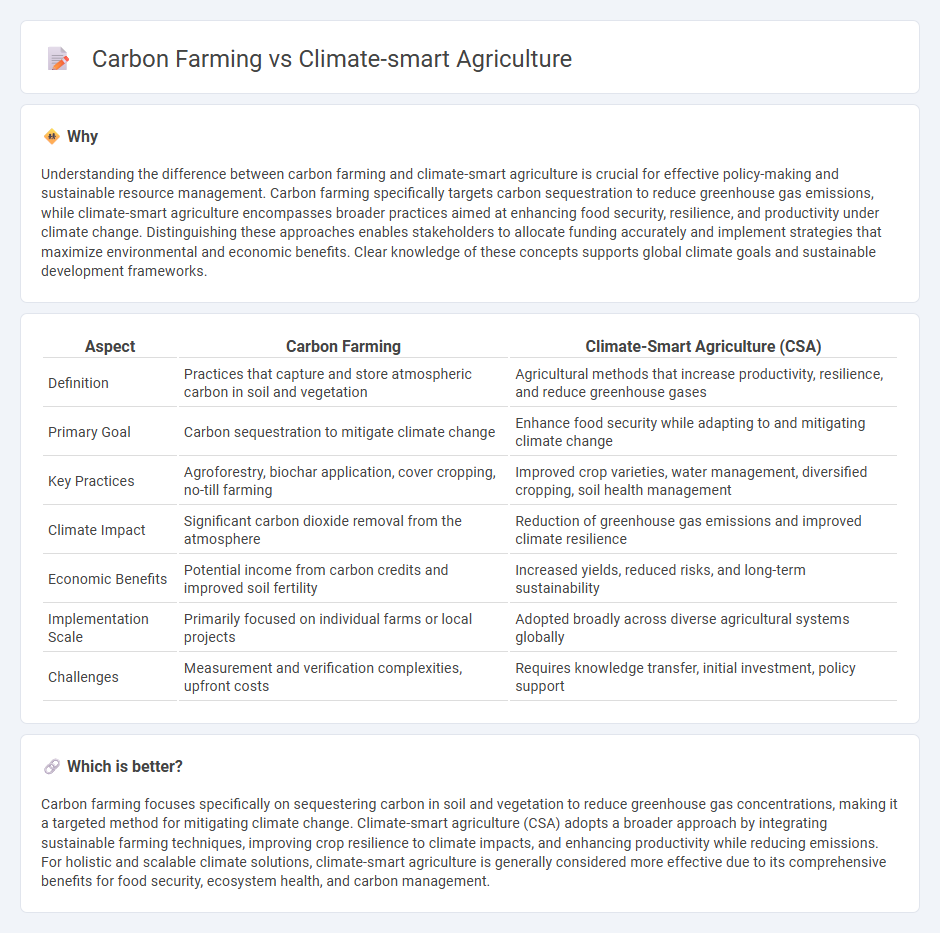
Carbon farming focuses on capturing atmospheric carbon dioxide through practices like agroforestry and cover cropping to reduce greenhouse gas emissions. Climate-smart agriculture integrates sustainable farming techniques, aiming to enhance productivity, resilience, and reduce agriculture's environmental footprint under changing climate conditions. Explore detailed strategies and benefits of both approaches to understand their roles in building a sustainable economy.
Why it is important
Understanding the difference between carbon farming and climate-smart agriculture is crucial for effective policy-making and sustainable resource management. Carbon farming specifically targets carbon sequestration to reduce greenhouse gas emissions, while climate-smart agriculture encompasses broader practices aimed at enhancing food security, resilience, and productivity under climate change. Distinguishing these approaches enables stakeholders to allocate funding accurately and implement strategies that maximize environmental and economic benefits. Clear knowledge of these concepts supports global climate goals and sustainable development frameworks.
Comparison Table
| Aspect | Carbon Farming | Climate-Smart Agriculture (CSA) |
|---|---|---|
| Definition | Practices that capture and store atmospheric carbon in soil and vegetation | Agricultural methods that increase productivity, resilience, and reduce greenhouse gases |
| Primary Goal | Carbon sequestration to mitigate climate change | Enhance food security while adapting to and mitigating climate change |
| Key Practices | Agroforestry, biochar application, cover cropping, no-till farming | Improved crop varieties, water management, diversified cropping, soil health management |
| Climate Impact | Significant carbon dioxide removal from the atmosphere | Reduction of greenhouse gas emissions and improved climate resilience |
| Economic Benefits | Potential income from carbon credits and improved soil fertility | Increased yields, reduced risks, and long-term sustainability |
| Implementation Scale | Primarily focused on individual farms or local projects | Adopted broadly across diverse agricultural systems globally |
| Challenges | Measurement and verification complexities, upfront costs | Requires knowledge transfer, initial investment, policy support |
Which is better?
Carbon farming focuses specifically on sequestering carbon in soil and vegetation to reduce greenhouse gas concentrations, making it a targeted method for mitigating climate change. Climate-smart agriculture (CSA) adopts a broader approach by integrating sustainable farming techniques, improving crop resilience to climate impacts, and enhancing productivity while reducing emissions. For holistic and scalable climate solutions, climate-smart agriculture is generally considered more effective due to its comprehensive benefits for food security, ecosystem health, and carbon management.
Connection
Carbon farming enhances soil carbon sequestration while climate-smart agriculture integrates adaptive practices to increase productivity and resilience under changing climatic conditions. Both approaches reduce greenhouse gas emissions and improve soil health, supporting sustainable agricultural economies. Their synergy drives climate mitigation efforts, promoting long-term economic stability in the agriculture sector.
Key Terms
Sustainable Productivity
Climate-smart agriculture integrates practices that enhance resilience, increase productivity, and reduce greenhouse gas emissions, prioritizing sustainable food systems amid climate change. Carbon farming emphasizes soil carbon sequestration techniques to capture atmospheric CO2, improving soil health and mitigating global warming. Explore the latest innovations and strategies to boost sustainable productivity and environmental benefits in agricultural practices.
Carbon Credits
Climate-smart agriculture integrates sustainable farming practices to improve resilience to climate change and enhance productivity while reducing greenhouse gas emissions. Carbon farming specifically targets the sequestration of carbon dioxide through techniques like agroforestry, cover cropping, and soil carbon enhancement, aiming to generate carbon credits as tradable emissions offsets. Discover how these approaches contribute to carbon credit markets and climate mitigation efforts.
Resilience to Climate Change
Climate-smart agriculture integrates sustainable practices like crop diversification and soil management to enhance resilience against climate change impacts, improving productivity and food security. Carbon farming emphasizes techniques such as agroforestry and biochar application to sequester atmospheric carbon, simultaneously mitigating greenhouse gas emissions and building ecosystem resilience. Explore detailed strategies and case studies to understand how these approaches contribute to climate resilience.
Source and External Links
Climate-smart agriculture - Climate-smart agriculture (CSA) is a set of farming methods focused on three goals: adapting to climate change impacts, increasing agricultural productivity and food security, and reducing greenhouse gas emissions, working as an integrated approach to land management to build resilience and sustainability in farming.
Climate-Smart Agriculture - CSA integrates practices and technologies tailored to specific conditions to boost productivity, enhance resilience against climate risks, and reduce emissions, achieving a "triple win" for sustainable food production and rural livelihoods especially for the poor.
The role of Climate-Smart Agriculture in climate adaptation and mitigation - Originally defined by the FAO in 2010, CSA guides farming by sustainably intensifying production, enhancing adaptation to climate change, and mitigating emissions through practices like conservation tillage, cover cropping, nutrient management, and agroforestry.
 dowidth.com
dowidth.com